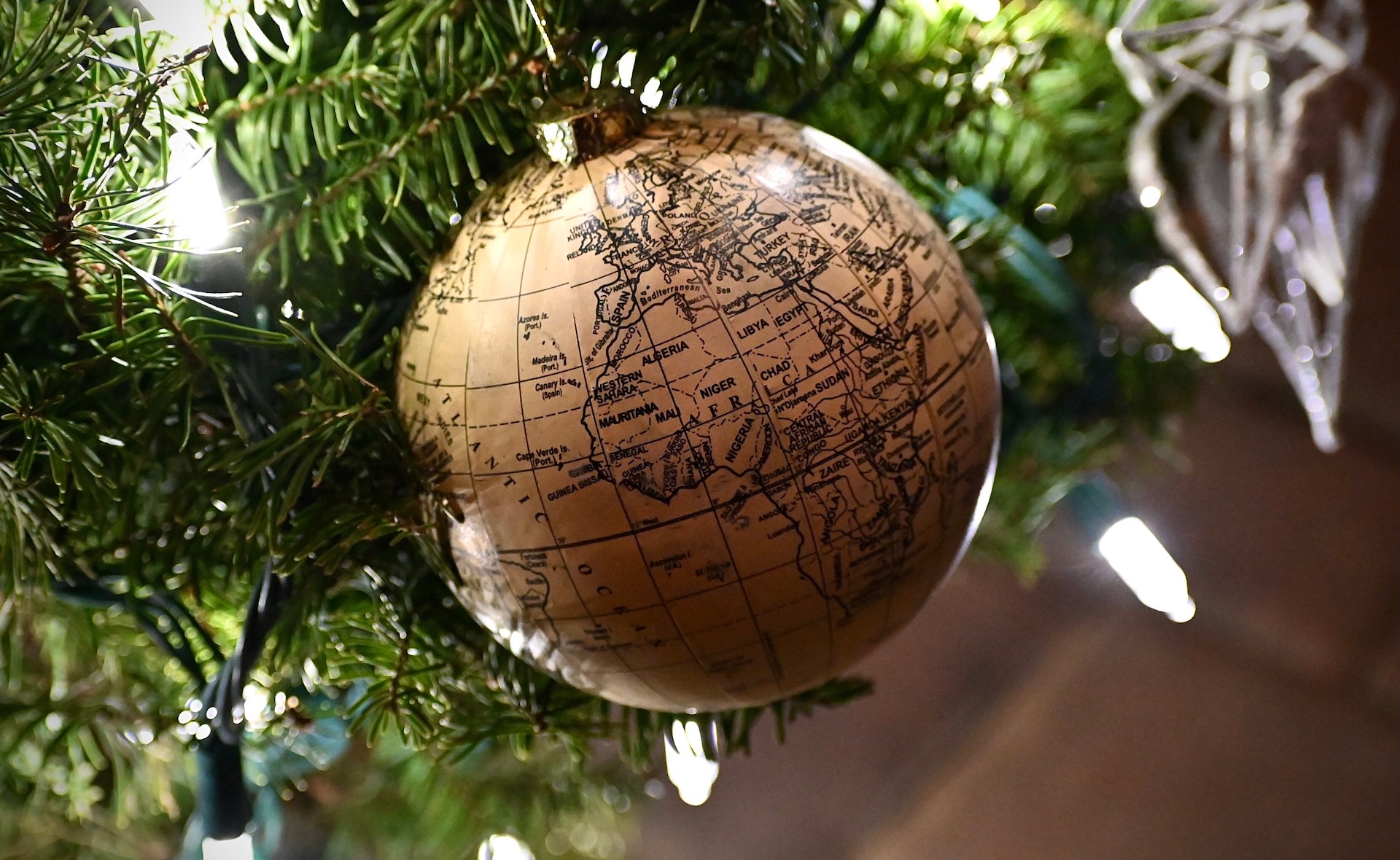
Whilst everyone is feeling festive, I thought it was time to reflect on the differences around the world focusing on a handful of different traditions from around the globe.
Christmas in Czechia / Czech Republic
During the evening of the 5th of December (St. Nicholas Eve), children are very excited and watch for St. Nicholas (Svatý Mikuláš) to arrive. He normally is accompanied by one or more angels and one or more devils. He asks the children if they’ve been good all year and asks them to sing a song or recite a poem, and gives them a basket of presents, often containing chocolate and fruit. If you’ve been naughty, the devil might give you a lump of coal. Like in the Netherlands and some other European countries, St Nicholas’ Day is a very separate holiday from Christmas.
In the Czech language, Happy/Merry Christmas is ‘Veselé Vánoce’. Happy/Merry Christmas in lots more languages.
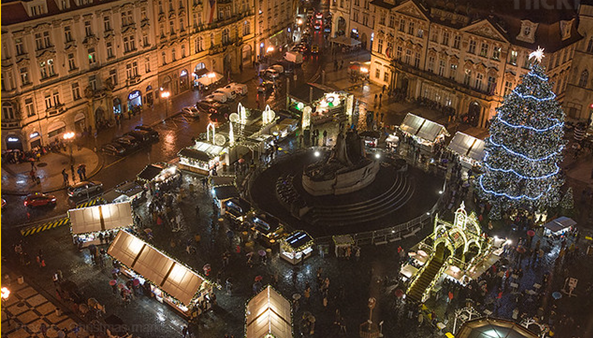
The main Christmas celebrations are on Christmas Eve. Some people fast during Christmas Eve in the hope that they will see a vision of ‘the golden pig’ appear on the wall before dinner! This is meant to be a sign of good luck.
The Czech traditional Christmas dinner is eaten during the evening of Christmas Eve. The meal often consists of fish soup (made of carp), and fried carp with potato salad.
There are some superstitions which some Czech families have surrounding the Christmas. Here is a selection of them:
- Washing/laundry must not be done or hung up on Christmas Eve or someone in the family might die!
- Fish scales are placed under the plates on the Christmas dinner table to hope that you will have enough money in the following year.
- Small candles are put into nutshells and are floated on water in a basin or bowl. If your nutshell stays at the edge, you’ll stay at home in the following year. If it floats far, you’ll leave your home and go ‘to the world’. If it turns over and sinks, you’ll die!
- After the meal, apples in half – across their ‘middle’. If you can see a star in the apple (i.e., there five apple seeds forming ‘a star’), it means good health in the following year. If there’s a cross (i.e., four apple seeds), you’ll die! If the apple has a worm hole, it means illness.
- Nobody is allowed to get up from their chair during the Christmas dinner. Everybody must wait to the end of the dinner otherwise the family won’t get together next year. The person who gets up is meant to die within a year!
- if you throw a shoe over your shoulder on Christmas day, if the toe points towards the door, you will be married soon!
Ježíšek ‘Little Jesus’ (the Czech version of Christ kind) brings presents during the Christmas Eve dinner and leaves them under the Christmas Tree. Czech children have their dinner in a different from where the tree is located. When they hear the bell ring (usually after the children have finished eating their main meal but when they are still at the table), that means that Ježíšek had been and has left their presents under the tree. The presents are normally opened right after dinner.
Religious families also usually sing Christmas carols by the tree and go to church either at midnight or on Christmas Day.
Christmas in Hungary
In Hungary, Christmas Eve is very important and is called ‘Szent-este’ which means Holy Evening. People spend the evening with their family and decorate the Christmas Tree. Sometimes only the adults decorate the tree (without the children there), so when children come in and see the tree, it’s a great surprise and they are told that angels brought the tree for them!
The main Christmas meal, which is also eaten on Christmas Eve, consists of fish (often fish soup called ‘Halászlé’ which is made with carp or other freshwater fish), stuffed cabbage (the leaves are stuffed with rice, mince pork, onion, garlic, and other herbs) and a special kind of poppy bread/cake called ‘Beigli’ is a popular dessert. Gingerbread is also a traditionally eaten at Christmas in Hungary. The gingerbread is often wrapped in very bright colors and decorated with Christmas figures.
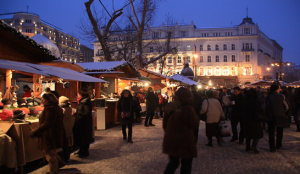
The Midnight Mass service is very popular in Hungary. Most people go to Church after their Christmas meal.
On Christmas Eve children also hope that they will be left some presents under the Christmas Tree. They’re told that the presents are brought by Jesus, he’s often called “Jézuska”, a nickname or cuter version for “Jézus”. Children wait outside the room where the tree is and when they hear bells ringing, they can enter, and the presents await them under the Christmas tree.
On Christmas Day people visit their families.
St. Nicholas also visits Hungary on the 6th of December. In Hungary he is known as ‘Mikulás’. Children leave out shoes or boots on a windowsill to be filled with goodies! Presents might also be brought by Télapó (Old Man Winter).
In Hungarian Happy/Merry Christmas is ‘Boldog karácsonyt’ (Happy Christmas) or ‘Kellemes karácsonyi ünnepeket’ (pleasant Christmas holidays). Happy/Merry Christmas in lots more languages.
Christmas in Costa Rica
Comes at the end of the school year and the start of the holidays – so people really look forward to getting to the beach!
People like to decorate their houses with beautiful tropical flowers. A model of the nativity scene, called the Pasito or Portal, is the center of the display. It’s also decorated with flowers and sometimes fruit. Some of the scenes take a long time to make and all the family is involved. As well as the traditional figures, people add other models including houses and lots of different sorts of animals.
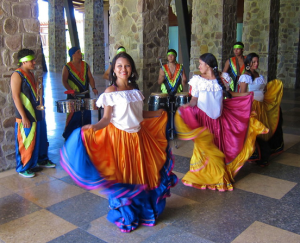
Christmas wreaths are made of cypress branches and are decorated with red coffee berries and ribbons. Most homes, shops and important buildings are decorated with Christmas lights.
In Costa Rica, the gift bringer is often ‘Niño dios’ (Child God, meaning Jesus) or ‘Colacho’ (another name for St. Nicholas).
Apples are popular in the run up to Christmas with apple stands appearing at the sides of the road.
On Christmas Eve, everyone puts on their best clothes and goes to Midnight Mass. In Costa Rica it’s called the ‘Misa de Gallo’ (Mass of the Rooster); it’s also called that in Spain.
After Midnight Mass the main Christmas meal is eaten. It normally includes chicken and pork tamales that have been wrapped for cooking in plantain leaves. To drink there’s lots of egg nog and rum punch!
During December and into January, there are lots of fiestas, parades, rodeos, street parties, bull runs and choral and dance festivals. On 26th December there is an important horseback parade called the Tope. The next on the next day (27th), many towns and cities have ‘Carnaval’ with a big parade featuring dancing and big floats.
Christmas in France
In France, a Nativity crib is often used to help decorate the house. French cribs have clay figures in them. During December some towns and cities, such as Marseilles, have fairs that sell Nativity figures. As well as having the normal Nativity figures in them, French scenes also have figures such as a Butcher, a Baker, a Policeman, and a Priest.
In French Happy/Merry Christmas is ‘Joyeux Noël’. In Breton (spoken by some people in Brittany, Northern France) it’s ‘Nedeleg Laouen’, in Corsican it’s ‘Bon Natale’ and in Alsatian (spoken by some people in Alsace, in Eastern France) it’s ‘E güeti Wïnâchte’. Happy/Merry Christmas in lots more languages.
One of the biggest Christmas markets in Europe is held in Strasbourg, in Northeastern France. In the Alsatian language it’s called the “Christkindelsmarik”.
Yule Logs made of Cherry Wood are often burned in French homes. An old tradition is that the log was carried into the home on Christmas Eve and sprinkled with red wine to make the log smell nice when it was burning. There is a custom that the log and candles are left burning all night with some food and drinks left out in case Mary and the baby Jesus come past during the night.
In France, Father Christmas / Santa Claus / St. Nicholas is called Père Noël (Father Christmas). In eastern France he is accompanied by Le Pere Fouettard, a man dressed in black. He might be the same person as Zwarte Piet/Sooty Piet/Roetpiet in The Netherlands.
The main Christmas meal, called ‘Réveillon’, is eaten on Christmas Eve/early Christmas morning after people have returned from the midnight Church Service. Dishes might include roast turkey with chestnuts or roast goose, oysters, foie gras, lobster, venison, and cheeses. For dessert, a chocolate sponge cake log called a bûche de Noël is normally eaten.
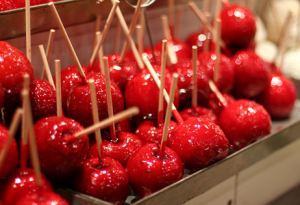
Another celebration, in some parts of France, is that 13 different desserts are eaten! All the desserts are made from different types of Fruit, Nuts and Pastries.
Epiphany (Épiphanie in French), called La Fêtes des Rois in French, is also celebrated in France on January 6th. A flat cake/tart made with, and puff pastry and almond cream is eaten called ‘Galette des Rois’. The cake traditionally has a ‘fève’ baked inside it (or put in the cream on the top). The fève was originally a bean (often made from porcelain, ceramic, or metal). Now it can be a little crown, a figure, or other shapes/small ornaments. The Galette des Rois is decorated on top with a gold paper crown. If you find the fève you wear the paper crown and are meant to bring the Galette des Rois the following year!
And to finish off ……………………….
Christmas in Sweden
Around Christmas time in Sweden, one of the biggest celebrations is St. Lucia’s Day (or St. Lucy’s Day) on December 13th. The celebration comes from stories that were told by Monks who first brought Christianity to Sweden.
St Lucia was a young Christian girl who was martyred, killed for her faith, in 304. The most common story told about St Lucia is that she would secretly bring food to the persecuted Christians in Rome, who lived in hiding in the catacombs under the city. She would wear candles on her head, so she had both her hands free to carry things. Lucy means ‘light’ so this is a very appropriate name.
December 13th was also the Winter Solstice, the shortest day of the year, in the old ‘Julian’ Calendar and a pre-Christian/pagan festival of lights in Sweden was turned into St. Lucia’s Day.
St. Lucia’s Day is now celebrated by a girl dressing in a white dress with a red sash round her waist and a crown of candles on her head. Small children use electric candles but from about 12 years old, real candles are often used!
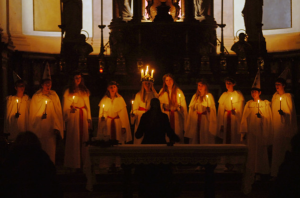
The crown is made of Lingonberry branches which are evergreen and symbolize new life in winter. Schools normally have their own St. Lucia’s, and some town and villages also choose a girl to play St. Lucia in a procession where carols are sung.
A national Lucia is also chosen. Lucias also visits hospitals and old people’s homes singing a song about St Lucia and handing out ‘Pepparkakor’, ginger snap biscuits.
Small children sometimes like dressing up as Lucia (with the help of their parents!). Also, boys might dress up as ‘Stjärngossar’ (star boys) and girls might be ‘tärnor’ (like Lucia but without the candles).
A popular food eaten at St. Lucia’s day are ‘Lussekatts’, St Lucia’s day buns flavored with saffron and dotted with raisins which are eaten for breakfast.
St Lucia’s Day first became widely celebrated in Sweden in the late 1700s. St Lucia’s Day is also celebrated in Denmark, Norway, Finland, Bosnia, and Croatia. In Denmark it is more a of a children’s day and in some part of Italy, children are told that St Lucy brings them presents. They leave out a sandwich for her and the donkey that helps carry the gifts!
On the first Sunday of Advent, called “Första Advent” in Swedish, many Swedes will put their Advent candles and/or an Advent Star in windows of their homes. Traditionally the Advent candles are four candles set in a ‘box’ which is decorated with greenery. One candle is lit on each Sunday during Advent. This custom came from the German Advent wreath. Often now an electric ‘stepped’ candle display is used instead of real candles.
Advent Stars were first made in the 1930s from red paper. The stars normally have seven (or sometimes nine) points and are about 30-45cms (12 to 18 inches) across. They have holes in them, and a light is put in them (now a safe electric one) so the light shines out. The stars are hung in a window to remind people that the wise men followed a star to find Jesus in the Christmas story. The stars are often now white and might be made of straw, wood, or metal as well as paper.
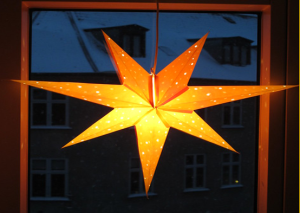
Christmas Eve is also very important in Sweden. This is when the main meal (well really a feast!) is eaten.
This is often a ‘julbord’ which is a buffet, eaten at lunchtime. Cold fish is important on the julbord. There is often herring (served in many ways), gravlax (salmon which has been cured in sugar, salt and dill) and smoked salmon.
Other dishes on the julbord might include cold meats including turkey, roast beef and ‘julskinka’ (a Christmas ham); cheeses, liver pate, salads, pickles and different types of bread and butter (or mayonnaise). There will also be warm savoury foods including meatballs, ‘prinskorv’ (sausages), ‘kåldolmar’ (meat stuffed cabbage rolls), jellied pigs’ feet, lutfisk (a dried cod served with a thick white sauce) and ‘revbenspjäll’ (oven-roasted pork ribs). Vegetables such as potatoes and red cabbage will also be served. Another potato dish is ‘Janssons Frestelse’ (matchstick potatoes layered with cream, onion and european sprats [a small fish] that is baked to a golden brown). There’s also ‘dopp i grytan’ which is bread that is dipped in the broth and juices that are left over after boiling the ham.
The dessert of the julbord might be a selection of sweet pastries, some more pepparkakor biscuits and some homemade sweets!
Wow, I think I like the sound of a Jolbord! To wash all that food down you can have some ‘glogg’ which is sweet, mulled wine and some coffee to finish off the meal!
Another popular food at Christmas in Sweden is ‘risgrynsgröt’ (rice porridge that’s eaten with ‘hallonsylt’ [raspberry jam] or sprinkled with some cinnamon). It’s often eaten during the evening after people have exchanged their presents.
If there is any risgrynsgröt left over, when it’s cold it can be mixed with whipped cream and eaten with a warm fruit sauce. This is called ‘Ris a la malta’ and sounds rather yummy!
Presents are normally exchanged on Christmas Eve. People often go to Church early on Christmas morning.
Another popular and important thing that many Swedes do on Christmas Eve afternoon is to watch old Disney cartoons! Every year, since 1959, at 3.00pm on Christmas Eve, the TV station TV1 shows the 1958 Disney special “From All of Us to All of You”. In Sweden it’s known as “Kalle Anka och hans vänner önskar God Jul” meaning “Donald Duck and his friends wish you a Merry Christmas.” About 40 to 50% of the Swedish population stop to watch it! It’s also shown on Christmas Eve afternoon in Denmark, Norway and Finland, but is most popular in Sweden.
Like their neighbors in Finland, there was a traditional belief in Sweden that a ‘Yule Goat’ was connected with the mid winter festival. In Sweden it was thought to be an invisible spirit that looked on and made sure all the preparations were going well. Between Christmas and New Year, men would sometimes dress up as goats and go from house to house singing songs and playing tricks! This is known as ‘Julebukking’.
Now, the goat is mainly seen as a straw ornament which guards the house and Christmas Tree! Straw is used as a decoration in homes, to remind them that Jesus was born in a manger. Christmas Tree decorations that are made of straw are also very popular.
In the city of Gävle, a huge straw goat is built every year for the start of Advent. It’s 13m/43ft tall and takes two days to put up! It has a large metal structure on the inside and is covered with straw. The tradition started in 1966. The first Gävle Yule Goat was burnt down on New Year’s Eve 1966 and ever since it’s been the target for vandals. In its 50 year history it’s only survived throughout the Christmas and New Year period about 15 times! In 2016, its 50th year, it was burnt down in less than two days!
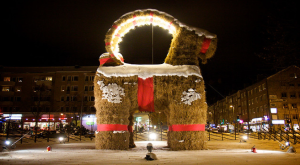
In Sweden, presents are brought by Santa who’s known as ‘Jultomten’ or by the ‘Tomte’ (Christmas Gnomes). Tomte are also sometimes called ‘Nissar’ (male elves/gnomes) or ‘Nissor’ (female gnomes/elves).
The ‘Secret Santa’ way of giving gifts might have also started in Sweden with a custom called ‘Julklapp’ (which means ‘Christmas knock’). Several hundred years ago there was a tradition where you would knock on the door of a friend or neighbour and then leave a small gift (often made from straw or wood) behind on the door step. The gift would have a little motto/riddle with it, to help people work out who had left the gift.
The end of Christmas in Sweden is on January 13th (twenty days after Christmas) which is called ‘Tjugondag Knut’ (Twentieth Day Knut) or ‘Tjugondag jul’ (Twentieth Day Yule) and is named after a Danish prince called Canute Lavard. On Tjugondag Knut it’s traditional that the Christmas Tree is taken down and left over cookies and sweets are eaten!
In Swedish Happy/Merry Christmas is ‘God Jul’. In North-Sami, spoken in northern parts of Norway, Sweden, Finland and Russia, it’s ‘Buorit Juovllat’
Have a great Christmas in which ever way you celebrate it, for me it’s simply a time when I can get together with family and friends and enjoy their company.
Merry Christmas
From
Howard and the Jubilee Family